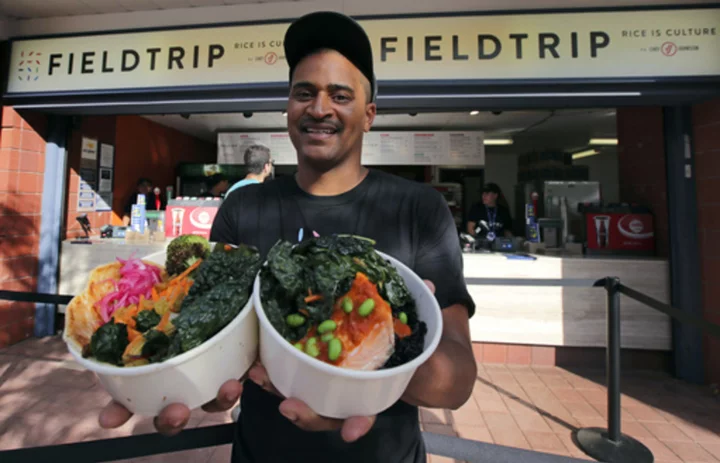NEW YORK (AP) — Chef JJ Johnson uses rice at home in many different ways — making crepes with his kids, using leftover rice for his wife's salad and frying it for dinner multiple ways. “Rice is a Swiss army knife. It can do so much for you,” he says.
This fall he's tried to prove that with the cookbook “The Simple Art of Rice,” an embrace of how the world has used the humble grain in everything from Seafood Paella to Thai Sticky Rice.
“I wanted people to realize that rice isn’t just a side dish, " he says. "You can have it for breakfast and dessert. It’s a salad. It could be a side, it could be a magnificent side, and it could be a complete dish.”
Johnson, who co-authored with food writer Danica Novgorodoff for Flatiron Books, begins with tips on mastering the basics — they endorse the washing of rice, for instance — as well as exploring the different kinds of grains you might encounter, like Carolina Gold, Jefferson Red and Thai Red Cargo.
Then it's off to the heart of the book — an exhilarating tour of dozens of global rice dishes, from fried balls of Mushroom and Goat Cheese Arancini from Italy, Chawal Roti using rice flour from India, and Spanakorizo, a spinach and feta dish from Greece.
“You see a lot of Caribbean rice. You see a lot of Latino rice. You see a lot of American rice dishes because that’s who I am. But then we dive into the Middle East, we go into China, we go to Peru, we go into a lot of places like that that celebrate rice,” he says.
Johnson leaned on his trips to rice-eating cultures like Israel, India, Singapore, Ghana and west Africa. He and Novgorodoff also include conversations with chefs David Chang, Pierre Thiam, Parisa Parnian and food historian Jessica B. Harris.
“The conversations were just great and joyful and delightful. And I think some of those conversations then shaped recipes we might have been missing, or took us in a good direction or told us we were at the right place,” he says.
Settling on a single representative dish to showcase took time and effort. Take jollof, a classic dish from Nigeria, Ghana and Senegal. Johnson chose Liberia's version, which is close to jambalaya.
“It was hard. I’m not going to lie. Every time that I thought I was complete, I wasn’t,” says Johnson, a James Beard Award -winning chef who co-wrote “Between Harlem and Heaven” and is the founder of FieldTrip rice restaurants in New York City.
“What I did was, I was like, ’OK, where are the places I’ve been that I’ve celebrated rice and had rice touch me? Where has rice been where I know it has touched people? And where are there rice dishes that we don’t know about that we need to learn how to cook at home?”
The gumbo he chose was the one his grandfather preferred, a Mississippi version with okra. “I wanted to tell that story. That gumbo is very unique to me and to my family. And there’s another gumbo that will be very unique to somebody else’s family and be celebrated.”
Johnson playfully says he's ready to be challenged on his selections of gumbo or jollof or arroz con gandules — Puerto Rico's signature dish of rice and pigeon peas. (Johnson chose not to wade into Japan’s love affair with rice, which could be an entire book on its own.)
“People are going to tell me I ain’t cooking the rice right. People are going to challenge me on washing rice,” he says. “I look at it as like, a beautiful thing. Rice is a conversation starter. It’s getting people talking. It’s getting us to learn new cultures.”
Rice in America has gotten a bad reputation, Johnson says, with some nutritionists disliking its starchiness and tendency to cause spikes in blood sugar. "I think rice is the most disrespected of ingredients," he says.
He urges rice-lovers to bypass the supermarket offerings and instead seek out local rice from farmers like Blue Moon Acres in Pennington, New Jersey; Ralston Family Farms in Atkins, Arkansas; and Lundberg Family Farms in Richvale, California.
Johnson hopes one day people will fuss over and compare rice varieties like they do coffee beans. “It could become a very fun approach to rice, where people then get to brag like, ‘Oh, what kind of rice you got there?’”
___
Mark Kennedy is at http://twitter.com/KennedyTwits









